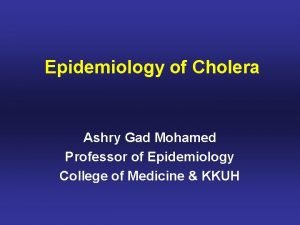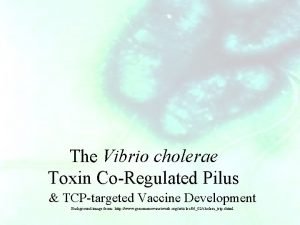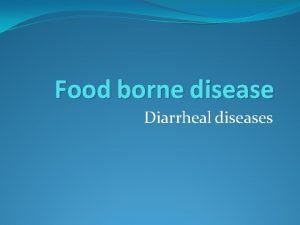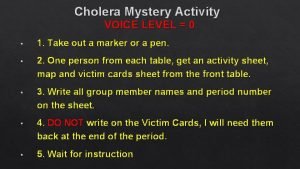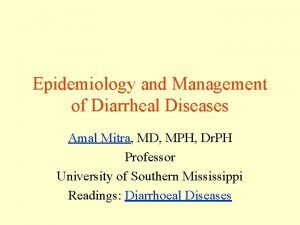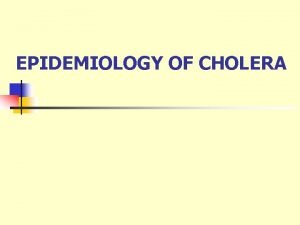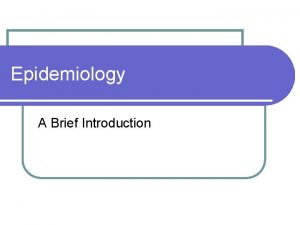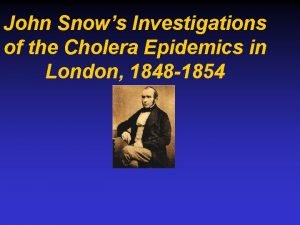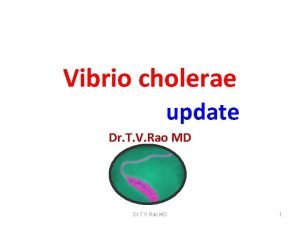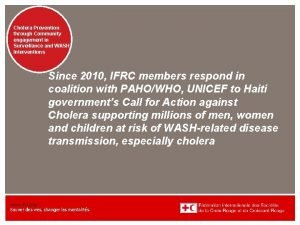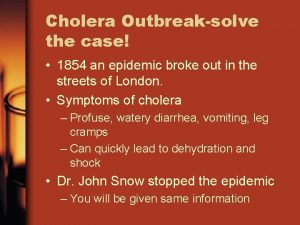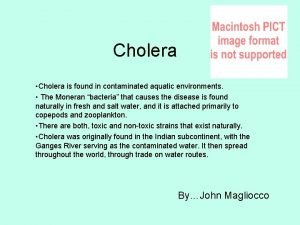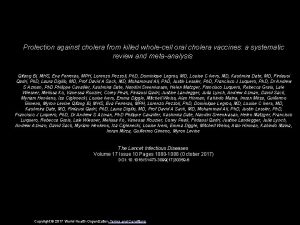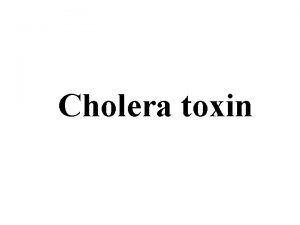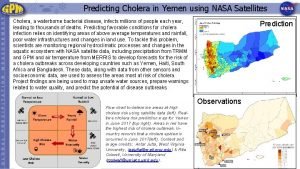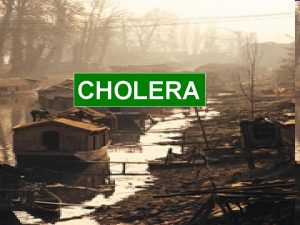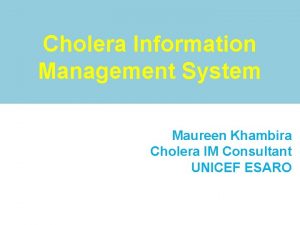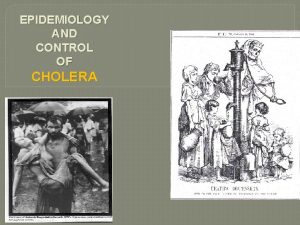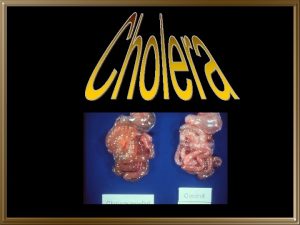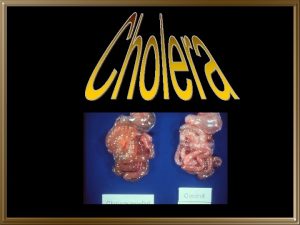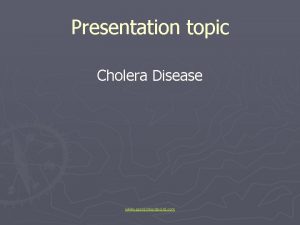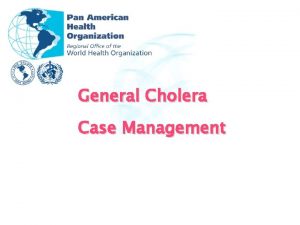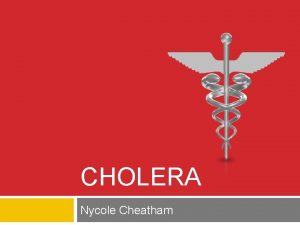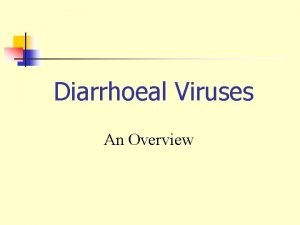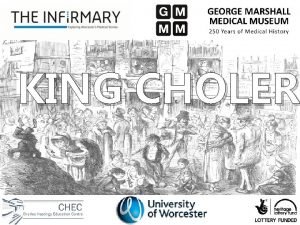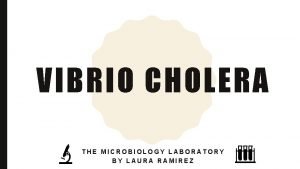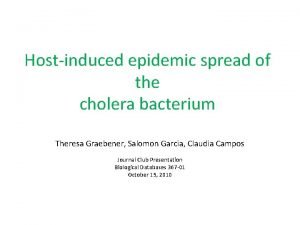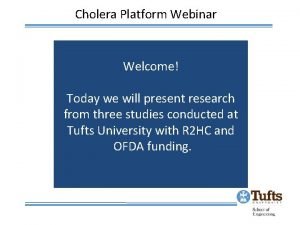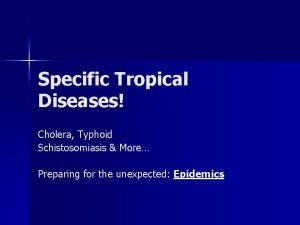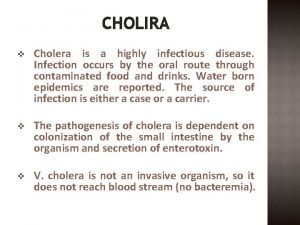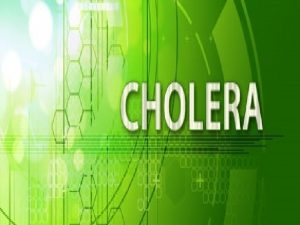Cholera n n n Cholera is a diarrhoeal























































- Slides: 55


Cholera n n n Cholera is a diarrhoeal disease caused by Vibrio cholerae, either type O 1 or O 139. Both children and adults can be infected. 20% of those infected develop acute, watery diarrhoea and 10 – 20% of these individuals develop severe watery diarrhoea with vomiting.


Cholera n n n It is usually transmitted through faecally contaminated water or food. Incubation period is very short ( 2 hours to 5 days ) and number of cases can rise extremely quickly, especially in over-populated communities and refugee setting. Case fatality rate in untreated cases may reach 30 – 50%.

Cholera: historical perspectives John Snow: identified contaminated water as the source of cholera spreading through London in 1849. Robert Koch: credited with identifying V. cholerae during the fifth pandemic in 1883. Filippo Pacini: was really the first to identify the organism in Italy in 1854.

Vibrio cholera and other Vibrios Family: Vibrionaceae Genus: Vibrio Gram-negative rods Single polar flagellum Rapid linear motility Natural habitat: environmental waters

Vibrio cholerae Structure is similar to the Enterobactericeae O antigen (cell surface lipopolysaccharide) H antigen (flagellar antigen) > 150 serotypes based on the O antigen 2 serotypes are associated with Cholera O 1 and O 139

Classification of Vibrio cholerae O 1 Three main serotypes (based on somatic antigens) Inaba Ogawa Hakojima Two biotypes (based on phenotypic characteristics) Classic El Tor

non-O 1 Vibrio cholerae May cause an illness similar to cholera. Acquired from contaminated water or seafood. Do not cause epidemics. Of less public health importance.

Clinical manifestations of cholera Abrupt onset of diarrhea without strain, tenesmus, or cramps. Spectrum of severity -- ranges from asymptomatic to a life-threatening, dehydrating diarrhea. All symptoms relate to the loss of fluid in the diarrhea.

ﻋﻮﺍﻣﻞ ﻣﻮﻟﺪ ﺍﺳﻬﺎﻝ ﻫﺎی ﻏیﺮ ﺍﻟﺘﻬﺎﺑی )آﻨﺘﺮﻭﺗﻮکﺴیﻨی (ﻭیﺒﺮیﻮ کﻠﺮﺍ Vibrio cholerae) (Enterotoxigenic E. Coli) (Clostridium Perfringens) (Bacillus Cereus) (Staphylococcus Aureus) (Aeromonas Hydrophila) (Plesiomonas Shigelloides) (Norwalk Like Viruses) (Rotaviruses) (Enteric Adenoviruses) (Giardia Lamblia) کﺮیپﺘﻮ ﺳپﻮﺭیﺪیﻮﻡ ﻭ ﺳیکﻠﻮﺳپﻮﺭﺍ

ﻋﻮﺍﻣﻞ ﻣﻮﻟﺪ ﺍﺳﻬﺎﻝ ﻫﺎی ﺍﻟﺘﻬﺎﺑی یﺎ ﺳیﺘﻮﺗﻮکﺴیﻨی (ﺷیگﻼ Shigella) (ﺳﺎﻟﻤﻮﻧﻼ Salmonella) (Compylobacter Jejuni) (Enterohemorrhagic E. Coli) (Enteroinvasive E. Coli) (Yersinia Enterocolitica) (Vibrio Parahemoliticus) (Clostridium Dificile) (Aeromonas Hydrophila) (Plesiomonas Shigelloides) (Entamoeba Histolytica)


Treatment of cholera I. Rehydration: crucial II. Antibiotics: less important - doxycycline - tetracycline - TMP-SMX - ciprofloxacin


Mild Mod Severe 5% 5 – 10% >10% Alert Restless Coma Pulse N Rapid Very rapid Severity N Weak Unpalpable Resp N Deep Very deep SBP N Low Very low Turgor Rapid slow Very slow Eyes N Sunken Very sunk Voice N Hoarse Not audible Urine N Scant Oliguria






Cholera Prophylaxis n Mass chemoprophylaxis is not effective in controlling a cholera outbreak. n Selective chemoprophylaxis ( one dose of doxycycline ) may be useful for members of a household who share food and shelter with a cholera patient. Chemoprophylaxis may be useful when a cholera outbreak occurs in a closed population, such as a prison.






Trend of cholera disease in I. R. Iran 1965 - 2005

Cholera disease in recent years 1377 1378 1379 1380 1381 1382 1383 1384 case 9897 1245 death 109 17 345 105 118 96 94 1118 3 1 1 0 1 11









Dead Cases Distribution

Trend of the Latest Cholera Epidemic

One Probable Feature

Positive Culture of specimens University Qazvin Qom Hamedan Golestan Iran Kashan Urumia Lorestan Sewage 205 15 3 -23 2 1 3 Vegetable 11 14 5 6 20 ----














